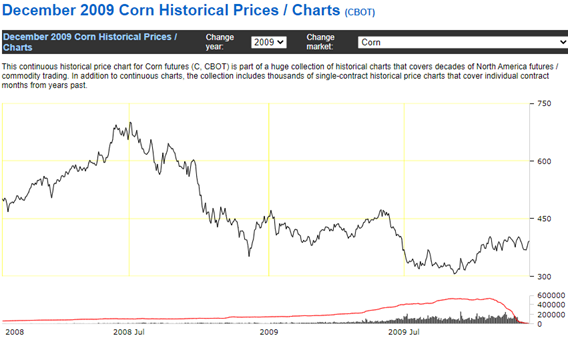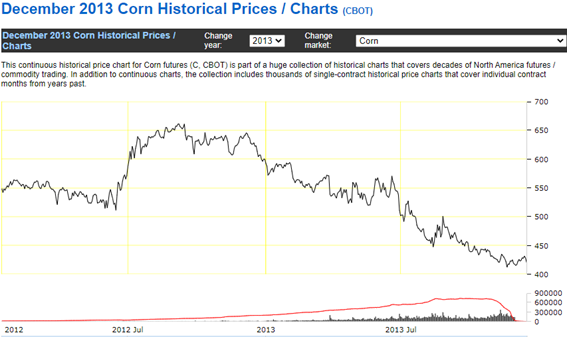
Throughout the holiday celebrations some of you were also doing office work, trying reach the income goal your tax specialist gave you by balancing income with paying out expenses.
While looking over which bills to pay in 2022 or 2023, farmers have experienced another year of high-priced inputs. Prices of chemicals, fertilizers, fuel, etc. have followed commodity prices higher and have taken away the profit margin many experienced in 2021 and 2022. With 2023 looking like a year of tighter margins, farmers are looking for places to save on costs.
One place today’s farmer may look to save costs is through marketing tools. With these high commodity prices, how bad can one mess up their sales? The answer to that question can be found by looking back a few years. 2009 and 2013 are both examples of years we locked in high input prices but saw commodity prices fall apart as the growing season progressed. Those years may have started with positive margins, but many found themselves in the red by the time harvest came around.


Just because prices are high now doesn’t mean they will be when you are looking to make sales. Options (puts and calls) are a great way to act on the markets and still remain flexible. At this time of year puts are used by many to lock in a futures price floor while bushels are unsold, keeping you protected but open to potential rallies.
Crop insurance questions
A question we receive from newer or prospective clients is, “Why do I need puts when I have a floor provided by my revenue protection crop insurance?” Let’s look at some simple math for answers.
Let’s say the Spring crop insurance price is $6.00; we take 85% RP coverage, and we have an APH of 200 bushels. This gives us a revenue guarantee of $1,020 ($6.00 x 85% x 200). A lot of people will claim that they have a floor of $6.00, but we must remember to take 85% of that to calculate our actual floor. If we take 85% of $6.00, we get an actual price floor of $5.10.
Well $5.10 isn’t the floor we thought we had, but it still isn’t terrible. However, we must remember we aren’t planning to just raise our APH. With better practices and technology, we are constantly raising corn 10, 15, or 20 percent higher than our APH. So, what happens to our price floor provided by crop insurance if we raise a crop higher than our APH? It continues to lower.
If we are guaranteed a revenue of $1,020 and we raise 220-bushel corn, just 10% higher than our APH, where does that put our “price floor”?
$1,020 divided by 220 is $4.63.
Now that is a price floor that is way lower than the $6.00 spring price -- $1.37 to be exact. What happens if sometime during the months March-September futures rally $1.50 higher on drought concerns but then fall back to $6.00 when we catch rains? Shouldn’t that price floor move higher with the market?
With RP crop insurance in this example, your floor is going to stay at $5.10 on your APH, or $4.63 on just a 10% higher yield.
Puts give us the opportunity to lock in higher price floors on your projected production and to manage them throughout the growing season, all without locking in physical sales. Recently we could buy a December 2023 $5.60 put for 30 cents; this would give a price floor of $5.30. We could lock that price floor in on our APH, or on that 10% higher yield we are expecting to produce.
What happens if we see that same $1.50 rally during the growing season? We would be able to manage our puts to a higher level. Maybe we could pay another 30 cents and move our puts up from $5.60 to $6.80. That would give us a price floor of $6.20 ($6.80-.30-.30=$6.20). If we caught rains and the market fell back down to $6.00, we would still have a floor of $6.20, 20 cents HIGHER than the market.
Crop insurance still needed
These examples are not to say crop insurance isn’t needed. Obviously if that drought does hit and our corn burns up, we are going to be very happy to have crop insurance. These examples are just to show that RP crop insurance does not replace the need for marketing tools, such as puts. They are an invaluable part of our farming operations and are definitely not one of the areas we should be looking to cut costs.
Years with tighter margins are the most important years to use options. Taking some control during volatile times and not being a victim to commodity markets can be the difference between having a solid year or using a red pen next holiday season in the office when you sneak out of a house full of in-laws!
Contact Advance Trading at (800) 664-2321 or go to www.advance-trading.com.
Information provided may include opinions of the author and is subject to the following disclosures:
The risk of trading futures and options can be substantial. All information, publications, and material used and distributed by Advance Trading Inc. shall be construed as a solicitation. ATI does not maintain an independent research department as defined in CFTC Regulation 1.71. Information obtained from third-party sources is believed to be reliable, but its accuracy is not guaranteed by Advance Trading Inc. Past performance is not necessarily indicative of future results.
The opinions of the author are not necessarily those of Farm Futures or Farm Progress.
About the Author(s)
You May Also Like






